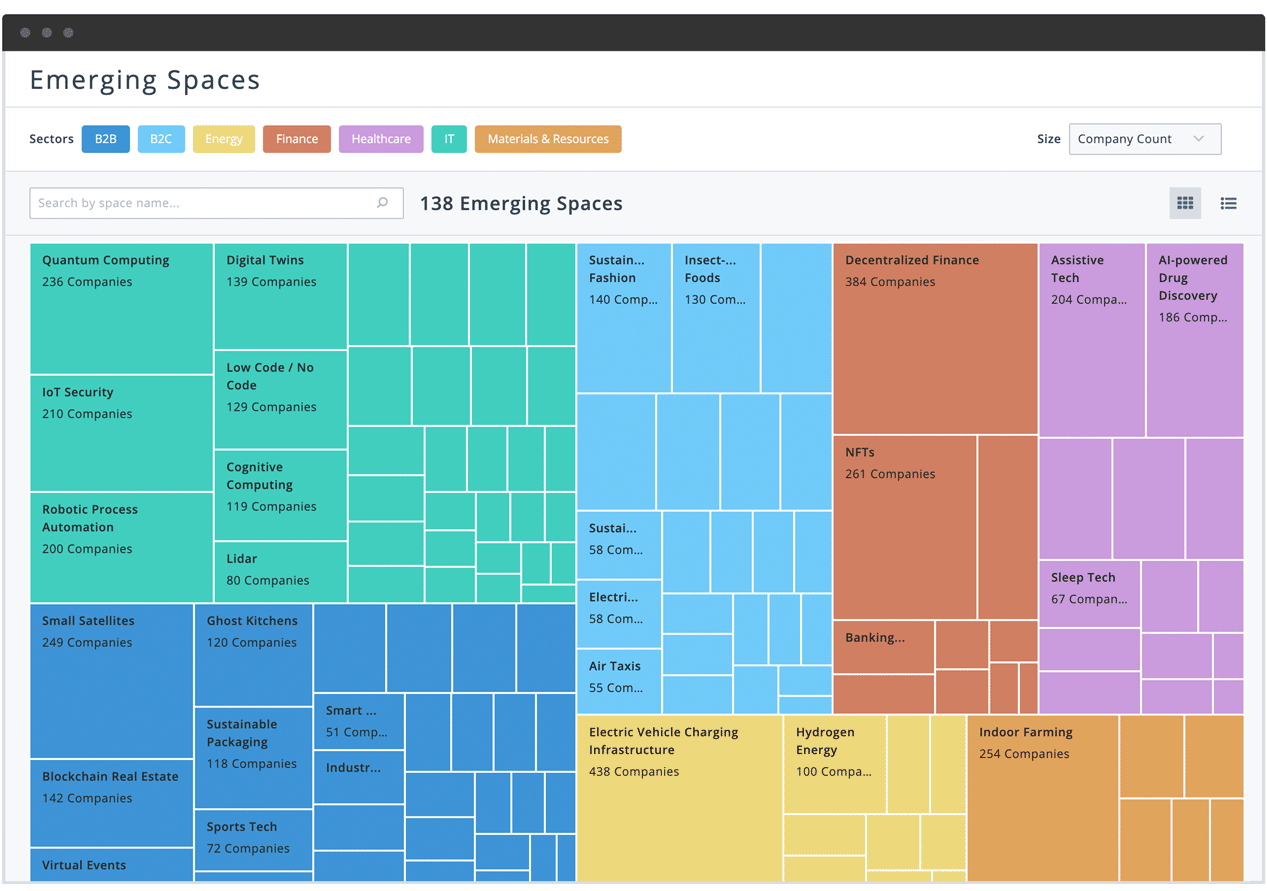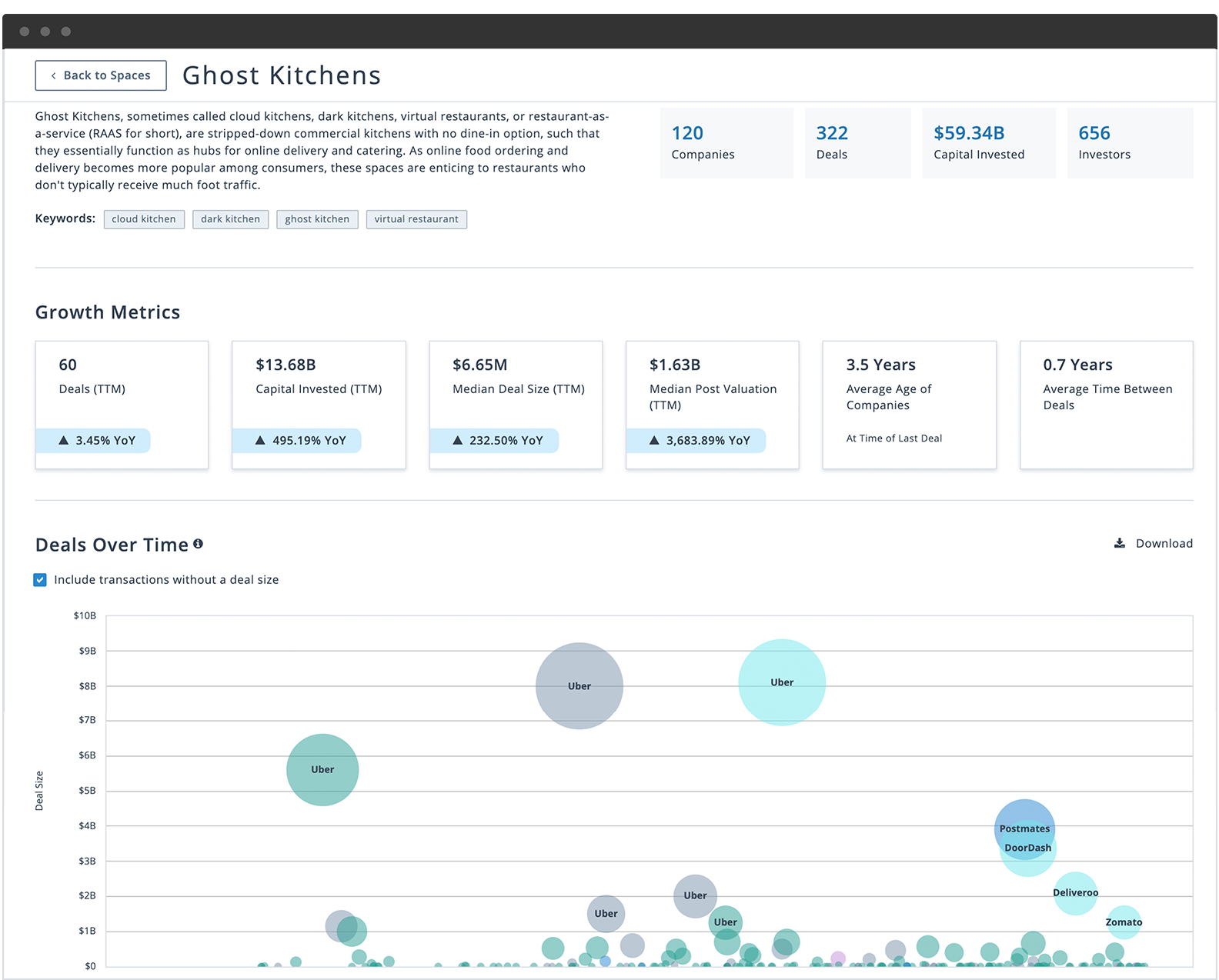Discover niche spaces on the rise before your competitors with PitchBook’s Emerging Spaces
September 14, 2021
New spaces within the VC landscape pop up all the time, and identifying those spaces in their nascency—before your competitors key in—can be a challenge. Monitoring market trends alone won’t put your firm at the forefront of these opportunities, but PitchBook’s new Emerging Spaces feature can help.
These emerging spaces are constantly changing, and often are too fluid to be categorized as an established industry or vertical. When trying to identify new investment spaces, searching within a traditional industry taxonomy can be limiting. This feature promotes discovery and gives PitchBook customers an advantage by providing actionable context on accelerating spaces.
Once you’ve identified an emerging space that’s relevant to your firm’s strategies and goals, track it in the platform over time and stay attuned to changes, growth and new opportunities within that area and others. In addition to complete deal, company and investor information for each emerging space, the feature highlights noteworthy changes so PitchBook customers never miss an important development or feel uninformed about the underlying details of those changes.
With a developing trend in sight, the analysis section of PitchBook’s Emerging Spaces feature allows users to dig deeper by surfacing growth metrics, deal visualizations, timely news coverage and data supporting each trend. With access to critical insights—including the number of companies founded in a new space by year, total deals in an emerging sector over time and year-over-year context for growth metrics—PitchBook clients can be more confident in pursuing and securing opportunities in the markets’ ascending areas.
Emerging technologies are used to provide research coverage of a broad industry that may include several types of products or technologies offered by startups that share similar characteristics. Emerging spaces consist of very specific products or technologies that may only represent a small segment or opportunity within a larger vertical.
PitchBook's Emerging Spaces feature
With Emerging Spaces, PitchBook clients can discover niche spaces on the rise within relevant sectors and identify promising investment trends beyond what they might otherwise unearth. Leveraging the expertise of PitchBook’s analysts and methodology developed by our data scientists, Emerging Spaces provides unparalleled insight into developing spaces—like carbon capture and removal, ghost kitchens, eVTOLs and air taxis, space tourism and clean meat.These emerging spaces are constantly changing, and often are too fluid to be categorized as an established industry or vertical. When trying to identify new investment spaces, searching within a traditional industry taxonomy can be limiting. This feature promotes discovery and gives PitchBook customers an advantage by providing actionable context on accelerating spaces.
Stay on top of changes as emerging spaces shift

Once you’ve identified an emerging space that’s relevant to your firm’s strategies and goals, track it in the platform over time and stay attuned to changes, growth and new opportunities within that area and others. In addition to complete deal, company and investor information for each emerging space, the feature highlights noteworthy changes so PitchBook customers never miss an important development or feel uninformed about the underlying details of those changes.
Use insight gleaned from PitchBook's Emerging Spaces to fuel action

With a developing trend in sight, the analysis section of PitchBook’s Emerging Spaces feature allows users to dig deeper by surfacing growth metrics, deal visualizations, timely news coverage and data supporting each trend. With access to critical insights—including the number of companies founded in a new space by year, total deals in an emerging sector over time and year-over-year context for growth metrics—PitchBook clients can be more confident in pursuing and securing opportunities in the markets’ ascending areas.
Emerging spaces FAQ
What methodology does PitchBook use to define an emerging space?
PitchBook defines emerging spaces using a set of criteria developed by our analyst team. To be designated as an emerging space and added to the platform feature accordingly, each space must represent:- Impressive innovation
- Rising awareness and popularity
- Accelerated growth
- Not be established enough (yet) to be considered an industry vertical
What emerging spaces does PitchBook track?
When the features launched in late 2019, PitchBook tracked roughly 70 emerging spaces. Since then, the number has expanded by about 50% to 138. To see a running list of all our emerging spaces—from desalination tech to smart mirrors—check out our blog post.Take a closer look at some of PitchBook’s emerging spaces:
- Election tech
- Climate tech
- Space tourism
- Carbon capture & removal
- Ghost kitchens
- Clean meat
- Neurotechnology
- Digital freight brokerage
- Insect-based foods
- eVTOLs and air taxis
How are emerging spaces different than emerging technologies?
Although emerging technologies and emerging spaces sound similar, they are not interchangeable. Emerging technologies is a term used widely across the industry, while emerging spaces are a unique concept that originated at PitchBook.Emerging technologies are used to provide research coverage of a broad industry that may include several types of products or technologies offered by startups that share similar characteristics. Emerging spaces consist of very specific products or technologies that may only represent a small segment or opportunity within a larger vertical.
Ready to discover PitchBook’s Emerging Spaces?
Not a PitchBook user yet? Request a free trial.
Comments:
Thanks for commenting
Our team will review your remarks prior to publishing.
Please check back soon to see them live.